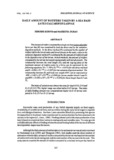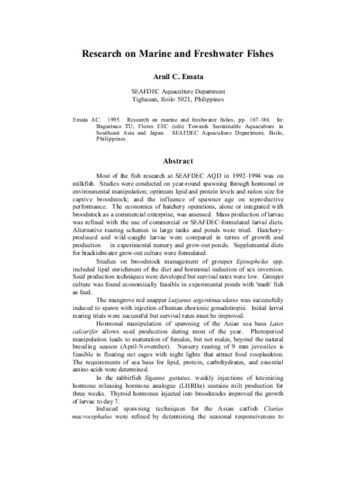Daily amount of rotifers taken by a sea bass Lates calcarifer larvae
- Global styles
- MLA
- Vancouver
- Elsevier - Harvard
- APA
- Help

View/Open
Date
1990Page views
3,445ASFA keyword
AGROVOC keyword
Taxonomic term
Metadata
Show full item recordShare
Abstract
The amount of rotifers consumed by a single sea bass Lates calcarifer larva per day (R) was examined by both the direct and by the satiation-digestion methods. In the direct method, R is estimated by the number of rotifers left in the larval tanks and larval density in the tanks, while in the satiation-digestion method R is estimated by the amount of rotifers found in the digestive tract of the larvae. In both methods, the amount of rotifers consumed by the larvae increased exponentially with larval growth. The relationship between the total length (TL) and the log-log plots of the maximum amount of rotifers eaten by a larva can be expressed by the following equations; R=1.799×TL4.398(r=0.975) for the direct method and R=4.861×TL3.432(r=0.907) for the satiation-digestion method. The relationship between TL and body wet weight (BW) can be expressed as: BW=2.607×10−4×TL3.786(r=0.960) for larvae smaller than 6.5 mm TL and BW=15.053×10−3×TL2.855(r=0.916) for those larger than 6.5 mm TL.
The index of satiation was almost the same for day 6(0-6), D-9 and D-12 (8.3-23%), higher range was observed in D-15 larvae. The index of daily feeding amount was comparatively higher in D-12 larvae compared to D-6, D-9 or D-15 larvae.
Suggested Citation
Kohno, H., & Duray, M. (1990). Daily amount of rotifers taken by a sea bass Lates calcarifer larvae. Philippine Journal of Science , 119(3), 247-255. http://hdl.handle.net/10862/1313
Type
ArticleISSN
0031-7683Collections
- Journal Articles [1249]
Related items
Showing items related by title, author, creator and subject.
-
Research on marine and freshwater fishes
Emata, Arnil C. (Aquaculture Department, Southeast Asian Fisheries Development Center, 1995)Most of the fish research at SEAFDEC AQD in 1992-1994 was on milkfish. Studies were conducted on year-round spawning through hormonal or environmental manipulation; optimum lipid and protein levels and ration size for ... -
Proceedings of the Seminar-Workshop on Aquaculture Development in Southeast Asia and Prospects for Seafarming and Searanching, 19-23 August 1991, Iloilo City, Philippines
Lacanilao, F.; Coloso, Relicardo M.; Quinitio, Gerald F. (Aquaculture Department, Southeast Asian Fisheries Development Center, 1994)Documents the presentations at ADSEA '91, the 2nd Seminar-Workshop on Aquaculture Development in Southeast Asia. ADSEA '91 includes reviews of the status of the researches conducted by Southeast Asian Fisheries Development ... -
Nursery and grow-out culture of high-value fish species in sea cages
Gaitan, Albert G.; Toledo, Joebert D. (Aquaculture Department, Southeast Asian Fisheries Development Center, 2009)





